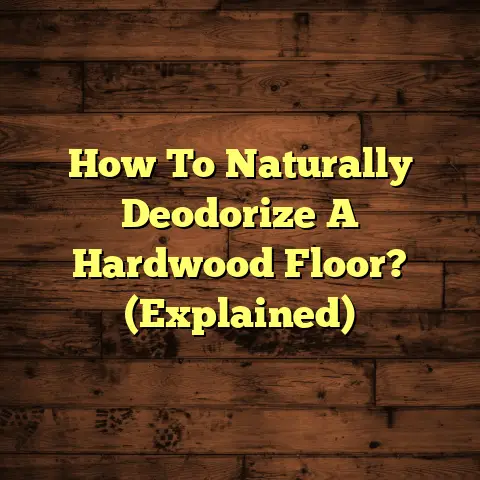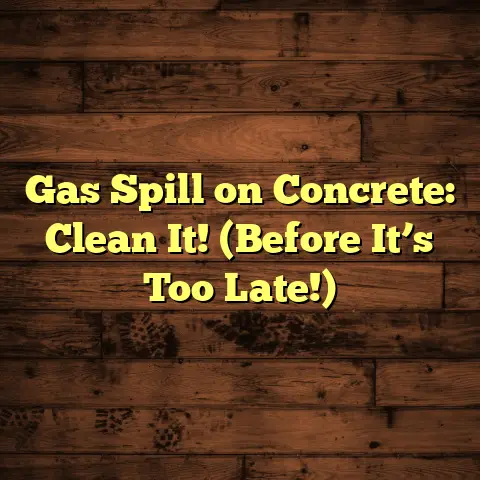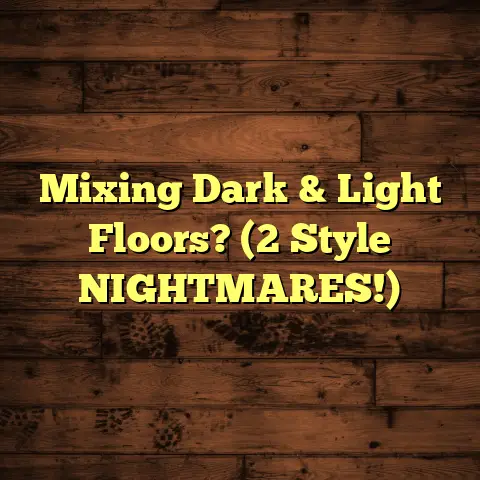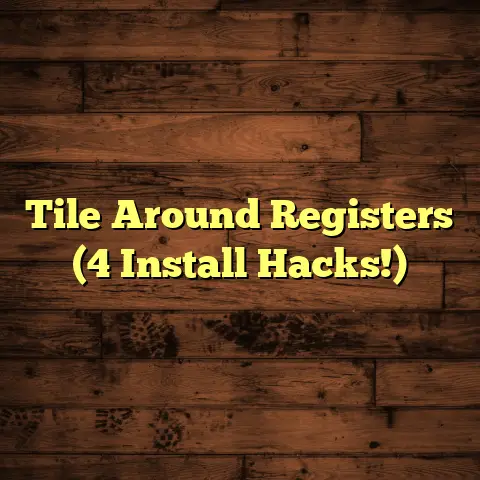Clean Rubber Gym Floor With What? (2 Cleaners FAIL!)
Endurance. It’s what we strive for in the gym, pushing our limits, building strength and stamina.
But what about the endurance of our gym itself? Specifically, those rubber floors that take a beating day in and day out?
A clean gym floor isn’t just about aesthetics; it’s about safety, hygiene, and creating a high-performance atmosphere.
Rubber flooring is a popular choice for gyms because it’s durable, shock-absorbing, and helps prevent injuries.
But let’s be honest, all that sweat, dropped weights, and spilled energy drinks can take their toll.
While you’re focused on crushing your personal best, the maintenance of your gym equipment, including the floor, is equally crucial.
So, what are the best cleaners for rubber gym floors? And why do some cleaners completely fail to deliver the promised results? I’ve seen it happen, and it’s frustrating!
Let’s dive in and uncover the secrets to keeping your rubber gym floor looking and performing its best.
Section 1: Understanding Rubber Gym Flooring
Okay, let’s get down to the nitty-gritty. What exactly is rubber gym flooring?
It’s not just one homogenous material, and understanding its composition is key to cleaning it properly.
Most rubber gym flooring is made from recycled or synthetic rubber. Recycled rubber often comes from old tires, which is great for sustainability!
Synthetic rubber offers more control over the material’s properties.
You’ll typically encounter three main types:
-
Rolled Rubber: This comes in long rolls and is often used to cover large areas. It’s durable and offers good shock absorption.
-
Rubber Tiles: These are interlocking squares, making them easier to install and replace. They’re also customizable in terms of color and design.
-
Rubber Mats: These are individual mats, often used in weightlifting areas or under specific pieces of equipment.
Each type has slightly different properties, but they all share the same core benefits:
-
Durability: Rubber can withstand heavy use and impact.
-
Shock Absorption: It protects joints and reduces noise.
-
Traction: It provides a non-slip surface for workouts.
But even the toughest rubber flooring isn’t invincible. Over time, you’ll likely see:
-
Scuff Marks: From shoes and equipment.
-
Stains: From sweat, spills, and dirt.
-
Odors: From bacteria and trapped moisture.
Regular cleaning and maintenance are essential to combat these issues and keep your floor in top condition. I can’t tell you how many times I’ve walked into a gym and been immediately hit with a funky smell. It’s not a great first impression!
Section 2: The Importance of Cleaning Rubber Gym Floors
Cleaning your rubber gym floor isn’t just about making it look pretty (although that’s a nice bonus!). It’s about hygiene, safety, and overall workout experience.
Think about it: your gym floor is a breeding ground for bacteria and germs. Sweat, dirt, and skin cells accumulate on the surface, creating a perfect environment for microbial growth.
According to a study published in the International Journal of Environmental Research and Public Health, gym surfaces can harbor a variety of bacteria, including Staphylococcus aureus (which can cause skin infections) and E. coli. (Source: Int. J. Environ. Res. Public Health 2020, 17(14), 5068; https://doi.org/10.3390/ijerph17145068)
Yikes! That’s not something you want to be rolling around on.
Unclean floors can also impact workout performance. A slippery floor increases the risk of slips and falls, which can lead to injuries.
Plus, let’s not underestimate the psychological impact of a clean gym environment. A clean and well-maintained space can boost motivation and make people more likely to stick to their fitness routines.
I always tell my clients, “Your gym is your temple. Treat it with respect!”
A clean gym floor contributes to:
-
Hygiene: Reduces the risk of infections and illnesses.
-
Safety: Prevents slips and falls.
-
Performance: Provides a stable and non-slip surface.
-
Motivation: Creates a positive and inviting workout environment.
So, cleaning your rubber gym floor is an investment in the health, safety, and success of your gym and its members.
Section 3: Common Cleaning Products for Rubber Gym Floors
Alright, let’s talk about cleaning products. There are a ton of options out there, but not all of them are created equal. I’ve tested a lot of them over the years, and I’ve definitely seen some winners and losers.
Here’s a breakdown of some common choices:
-
Commercial Floor Cleaners: These are specifically formulated for cleaning floors and are often used in commercial settings like gyms.
-
Cleaner A: “Gym Clean Pro” This is a popular choice, marketed for its ability to remove sweat, dirt, and odors. It contains detergents, solvents, and fragrance.
-
Cleaner B: “Floor Shield” This cleaner boasts a protective layer that prevents dirt buildup and makes future cleaning easier. It contains polymers and surfactants.
While these cleaners can be effective, they can also be harsh on rubber if not diluted properly. Some may also leave a residue that can make the floor slippery.
-
-
Homemade Cleaners: DIY cleaning solutions are often cheaper and more environmentally friendly.
-
Vinegar and Baking Soda: A classic combination! Mix equal parts vinegar and water in a spray bottle, then sprinkle baking soda on the floor. Let it fizz for a few minutes, then scrub and rinse.
- Recipe: 1/2 cup white vinegar, 1/2 cup water, baking soda.
-
Dish Soap: A mild dish soap can be used to clean rubber floors. Mix a small amount with water and mop the floor. Be sure to rinse thoroughly to remove any soap residue.
- Recipe: 1 tablespoon mild dish soap per gallon of water.
The problem with homemade cleaners is that they can be inconsistent. The concentration of the cleaning agent can vary, and some ingredients (like baking soda) can be abrasive if used incorrectly.
-
-
Enzymatic Cleaners: These cleaners use enzymes to break down organic matter like sweat, blood, and urine. They’re particularly effective at removing odors.
-
Enzymatic cleaners are a great option for gyms because they target the source of the odor rather than just masking it. They’re also generally safe for rubber and won’t leave a residue.
-
However, they can be more expensive than other cleaning options, and they may not be as effective at removing dirt and grime.
-
Here’s a quick comparison table:
| Cleaner Type | Pros | Cons |
|---|---|---|
| Commercial Cleaners | Effective, readily available | Can be harsh, may leave residue |
| Homemade Cleaners | Cheap, environmentally friendly | Inconsistent, can be abrasive, may not be as effective |
| Enzymatic Cleaners | Breaks down organic matter, removes odors, safe for rubber | More expensive, may not be as effective at removing dirt and grime |
Choosing the right cleaner depends on your specific needs and the type of rubber flooring you have. Always test a small, inconspicuous area first to make sure the cleaner doesn’t damage the floor.
Section 4: Case Studies of Two Cleaners That Failed
Okay, let’s get to the juicy part: the cleaning product fails! I’m going to share two real-life examples of cleaners that just didn’t cut it when it came to cleaning rubber gym floors.
Case Study 1: “Gym Clean Pro”
-
Product Overview: “Gym Clean Pro” is a widely marketed commercial cleaner specifically designed for gym floors. It promises to remove sweat, dirt, and odors, leaving a fresh, clean scent. It’s available in concentrated form and is meant to be diluted with water.
-
Cleaning Test: I used “Gym Clean Pro” in a mid-sized gym with rolled rubber flooring. I followed the instructions on the bottle, diluting the cleaner with water according to the recommended ratio. I mopped the floor with the solution, allowing it to sit for a few minutes before rinsing with clean water.
-
Results: Initially, the floor looked clean and smelled fresh. However, after a few hours, I noticed a sticky residue on the surface. This residue attracted dirt and made the floor feel slippery. Gym members complained that their shoes were sticking to the floor, which was a safety hazard.
Furthermore, the cleaner didn’t effectively remove some of the tougher stains, such as dried sweat and spilled sports drinks. After a week of using “Gym Clean Pro,” the floor actually looked dirtier than before.
One gym member, Sarah, told me, “I almost slipped during my workout! I thought the floor was clean, but it felt really sticky.”
-
Conclusion of the Case Study: “Gym Clean Pro” failed because it left a sticky residue that attracted dirt and created a safety hazard. The cleaner also didn’t effectively remove tough stains. The lesson learned is that a cleaner that smells good and looks clean initially may not be the best choice for rubber gym floors.
Case Study 2: Vinegar and Baking Soda
-
Product Overview: Vinegar and baking soda are popular DIY cleaning agents known for their natural and environmentally friendly properties. They’re often recommended for cleaning a variety of surfaces, including floors.
-
Cleaning Test: I tested the vinegar and baking soda solution on a smaller area of rubber tile flooring in a home gym. I mixed equal parts vinegar and water in a spray bottle, sprayed the solution on the floor, and sprinkled baking soda on top. I allowed the mixture to fizz for a few minutes before scrubbing with a brush and rinsing with clean water.
-
Results: The vinegar and baking soda solution did a decent job of removing some of the surface dirt and grime. However, it didn’t effectively remove scuff marks or stains. The baking soda also left a powdery residue that was difficult to remove completely.
Over time, I noticed that the vinegar seemed to be drying out the rubber, making it feel brittle and less flexible. This could potentially lead to cracking and damage to the flooring.
One user, Mark, commented, “The vinegar smell was overpowering, and the baking soda left a gritty residue. I wouldn’t use this on my gym floor again.”
-
Conclusion of the Case Study: While vinegar and baking soda are effective for some cleaning tasks, they’re not ideal for rubber gym floors. The vinegar can dry out the rubber, and the baking soda can leave a residue. The lesson learned is that natural cleaning agents aren’t always the best choice for all surfaces.
These case studies highlight the importance of choosing the right cleaning product for your rubber gym floor. Just because a cleaner is popular or natural doesn’t mean it’s the best option. Always consider the specific properties of your flooring and test any new cleaner in a small, inconspicuous area before using it on the entire floor.
Section 5: Best Practices for Maintaining Rubber Gym Floors
Okay, so you know what not to do. Now let’s talk about the best practices for keeping your rubber gym floor clean and in good condition.
-
Routine Cleaning Schedule: Regular cleaning is key to preventing dirt and bacteria buildup. I recommend cleaning your rubber gym floor at least once a week, and more often if it’s a high-traffic area.
-
Daily: Sweep or vacuum the floor to remove loose dirt and debris.
-
Weekly: Mop the floor with a recommended cleaner.
-
Monthly: Deep clean the floor with an enzymatic cleaner to remove odors and break down organic matter.
-
-
Spot Cleaning: Address spills and stains immediately to prevent them from setting in. Use a clean cloth or paper towel to blot the spill, then clean the area with a mild cleaner.
-
Preventive Measures: Taking steps to prevent dirt and damage can significantly reduce the need for extensive cleaning.
-
Use mats at entrances: To trap dirt and debris before they reach the gym floor.
-
Encourage gym members to wipe their shoes: Before entering the workout area.
-
Provide cleaning supplies: So gym members can clean up spills and messes immediately.
-
-
Managing Spills: Spills are inevitable in a gym environment. Here’s how to handle them:
-
Act quickly: The longer a spill sits, the harder it will be to remove.
-
Blot, don’t rub: Rubbing can spread the spill and damage the floor.
-
Use the right cleaner: Choose a cleaner that’s appropriate for the type of spill.
-
-
Tracking Dirt: Dirt can be tracked into the gym from shoes, equipment, and even the air.
-
Use walk-off mats: At entrances to trap dirt and debris.
-
Regularly sweep or vacuum: The floor to remove loose dirt.
-
Consider an air purifier: To reduce the amount of airborne dirt and dust.
-
-
Maintaining the Floor’s Appearance: To keep your rubber gym floor looking its best:
-
Avoid harsh chemicals: That can damage the rubber.
-
Use a pH-neutral cleaner: To prevent discoloration.
-
Protect the floor from direct sunlight: Which can cause fading.
-
By following these best practices, you can prolong the lifespan of your rubber gym floor and ensure that it remains clean, safe, and inviting for years to come.
Section 6: Conclusion
Choosing the right cleaning products for your rubber gym floors is super important. I’ve seen firsthand what happens when you don’t!
Remember those two cleaners that failed? They’re a perfect example of how important it is to know your stuff.
Just like you need the right gear to push through a tough workout, you need the right cleaner to keep your gym floor in top shape.
Think about it: your gym is where you build endurance, strength, and resilience. But that endurance depends on a clean, safe environment.
A slippery, dirty floor can lead to injuries and discourage people from working out. A clean, well-maintained floor, on the other hand, can boost motivation and create a positive workout experience.
So, be smart about your cleaning choices. Don’t just grab the first product you see on the shelf. Do your research, read reviews, and consider the specific needs of your rubber gym floor.
And remember, just as fitness requires dedication and effort, so does maintaining a safe and clean workout space.
Your gym members will thank you for it!





